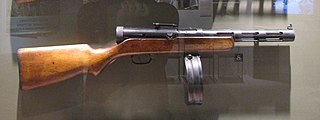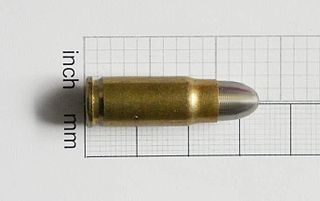History
Designed in the mid-1950s, the M57 was an unlicensed copy of the Soviet TT-33 Tokarev. [2] The Yugoslav People's Army had initially attempted to adopt the TT as its standard service pistol after World War II, and a number were delivered by the Soviet Union. [2] However, the Tito–Stalin split prompted the Soviet government to cease military aid to Yugoslavia before deliveries of the pistol were fully completed. [2] In 1952, Zastava was charged with developing its own variant of the TT to satisfy the army's needs. [3] Zastava's engineers were able to reverse engineer the weapon by 1954. [2] However, its factory was already at capacity manufacturing rifles and submachine guns, and it was unable to open a new production line to produce the TT. [3] The project was shelved until 1956, when army officials again expressed interest in the TT design. [2] Work on an improved TT derivative began in earnest in 1957, and the first prototypes appeared in 1960. [2] The Zastava pistol was formally designated M57 and accepted for service in 1961. [2] Although the army took delivery of various pre-production models that year, serial production was delayed until 1963. [2]
Zastava manufactured the M57 from 1963 until 1982, at which time at least 260,000 had been produced. [3] It was retired from military service in the former Yugoslavia during the late 1990s and early 2000s, being largely superseded by the Zastava CZ99. [2]
M57 or M-57 may refer to:

The Mauser C96 is a semi-automatic pistol that was originally produced by German arms manufacturer Mauser from 1896 to 1937. Unlicensed copies of the gun were also manufactured in Spain and China in the first half of the 20th century.

The Beretta Model 1934 is an Italian compact, semi-automatic pistol which was issued as the service pistol of the Royal Italian Army beginning in 1934. As the standard sidearm of the Italian army it was issued to officers, NCOs and machine gun crews. It is chambered for the 9mm Corto, more commonly known as the .380 ACP.

The 7.62×25mm Tokarev cartridge is a Soviet rimless bottleneck pistol cartridge widely used in former Soviet states and in China, among other countries. The cartridge has since been replaced in most capacities by the 9×18mm Makarov in Russian service.

The TT-30, commonly known simply as the Tokarev, is a Soviet semi-automatic pistol. It was developed in 1930 by Fedor Tokarev as a service pistol for the Soviet military to replace the Nagant M1895 revolver that had been in use since the Russian Empire, though it ended up being used in conjunction with, rather than replacing, the M1895. It served with the Soviet Armed Forces until 1952, when it was replaced by the Makarov pistol.

The Beretta M1951 is a 9×19mm semi-automatic pistol developed during the late 1940s and early 1950s by Pietro Beretta S.p.A. of Italy. The pistol was produced strictly for military use and was introduced into service with the Italian Armed Forces and other Italian security forces as the Modello 1951 (M1951), replacing the Modello 1934 pistol chambered for the 9×17mm Short cartridge.

The PPD is a submachine gun originally designed in 1934 by Vasily Degtyaryov. The PPD had a conventional wooden stock, fired from an open bolt, and was capable of selective fire. It was replaced by the PPSh-41.

The Zastava M76 is a military semi-automatic designated marksman rifle developed and manufactured by Zastava Arms.

The Zastava M85 is a carbine designed and produced by then Yugoslavian Zastava Arms. It is a shortened version of the original rifle, the Zastava M80, which is itself successor to the Zastava M70 assault rifle. The M85 is practically same as the carbine version of the M70, the Zastava M92, the only difference being in caliber, and in this case, the magazine design, as same as with original rifles, the M70 and M80.

The Type 54 and its variants are Chinese copies of the Soviet type Tokarev TT-33.

Zastava Arms is a Serbian manufacturer of firearms and artillery, based in Kragujevac, Serbia. In 1853, it was founded, and cast its first cannon. It is the leading producer of firearms in Serbia and is a large contributor to the local defense industry. Zastava Arms produces and exports a wide variety of products to over forty countries, including the Zastava M70, a Kalashnikov rifle.
The Zastava M70 is a 7.62×39mm assault rifle. Developed in the Socialist Federal Republic of Yugoslavia by Zastava Arms during the 1960s, the M70 was an unlicensed derivative of the Soviet AK-47. Due to political differences between the Soviet Union and Yugoslavia at the time, namely the latter's refusal to join the Warsaw Pact, Zastava was unable to directly obtain the technical specifications for the AK and opted to reverse engineer the weapon type. Although the M70 was functionally identical to the AK, it had unique in-built features that better enabled it to fire rifle grenades. These included a thicker receiver, a new latch for the dust cover to ensure it wouldn't be jarred loose by a grenade discharge, and a folding grenade sight bracket over the rifle's gas block, which also shut off the gas system when raised.

The Pistol Mitralieră model 1963/1965 is a Romanian 7.62x39mm assault rifle. Developed in the late 1950s, the PM md. 63 was a derivative of the Soviet AKM produced under license. It was the standard issue infantry weapon of the Army of the Socialist Republic of Romania until the late 1980s, after which it was gradually superseded by the Pușcă Automată model 1986, a derivative of the Soviet AK-74.

The Tokarev Model 1927 submachine gun was an experimental firearm developed in the Soviet Union under the leadership of Fedor Vasilievich Tokarev as part of the Soviet Union's drive to be self sufficient in armaments. It was a blowback-operated, two trigger weapon which fired a 7.62 mm round originally intended as a revolver round.

The Zastava M88 is a semi-automatic pistol produced by Zastava Arms, it is a compact redesign of the Zastava M57 pistol.

The PPS is a family of Soviet submachine guns chambered in 7.62×25mm Tokarev, developed by Alexei Sudayev as a low-cost personal defense weapon for reconnaissance units, vehicle crews and support service personnel.

The 7.63×25mm Mauser round was the original cartridge for the Mauser C96 service pistol. This cartridge headspaces on the shoulder of the case. It later served as the basis for the 7.62mm Tokarev cartridge commonly used in Soviet and Eastern Bloc weapons.

The Zastava M70, formerly designated CZ M70 is a semi-automatic pistol produced by Zastava Arms as a sidearm for Yugoslav police and certain military officers. The pistol was loosely based on the Zastava M57, but is scaled down to accept the smaller and less powerful 7,65mm Browning or 9mm Kratak.

The Zastava CZ99 is a semi-automatic pistol produced by Zastava Arms. It was developed in 1989 to replace the M57 in the Yugoslav military and police. The CZ99 is primarily chambered in 9×19mm Parabellum with a 15-round magazine, although .40 Smith & Wesson variants also exist, with ten-round magazines.

















